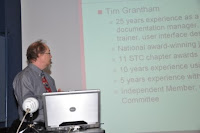At our November meeting, Tim Grantham from Front Runner Training offered a practical training session on what might be considered herding ducks – making documents line up nicely into a row so they can be moved into and managed in DITA.
In his “7 Simple Steps to DITA” talk, Tim acknowledged that simple rarely means easy, but encouraged us to cling to the goal of using DITA to achieve productivity gains. “There’s a lot of wasted energy in managing conventional documents,” Tim says. That includes manually reformatting translated documents, manually copying and pasting content from one document to another, manually updating copies of content in multiple documents and manually converting documents from one proprietary format to another.
So what’s Tim’s recommended starting point? “Identify a common document type. Really dig in to find the documents that belong together... the shorter and more commonly used the better. His next steps?
Step 2 – Identify the structural elements common to most instances of the document type. For a product brochure, this might be title, product, value proposition, features and benefits, contact information.
Step 3 – Identify common content.
Step 4 – Identify unique content. Example: product name will be different from one brochure to the next.
Step 5 - Define a form or content template for each document type.
Define variables/ properties for fragments of content that occur frequently within an instance of the document type.
Step 6: Once you have standardized structure, then standardize content. Find chunks of content that are the same everywhere they are used.
Step 7: Standardize formatting. Keep paragraph, character, table styles as simple as possible.
Other hints for beginners: Use only defined styles. Define the number of text styles that you really need and resist every urge to start customizing. Define styles for structural elements – titles, images, terms, cross-references.
Tim’s recommendations for additional investigation: DITA Open Toolkit, a software add-on that can apply formatting to content. Tim says it is fast and reliable but that customizing the default formats is complicated for non-technical users. He also recommends Introduction to DITA, a new book by JoAnn Hackos.





No comments:
Post a Comment